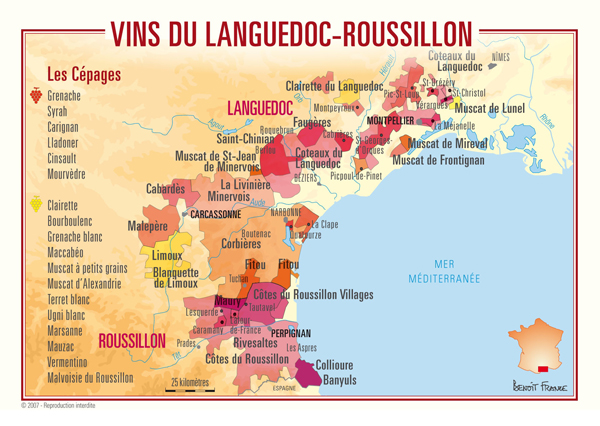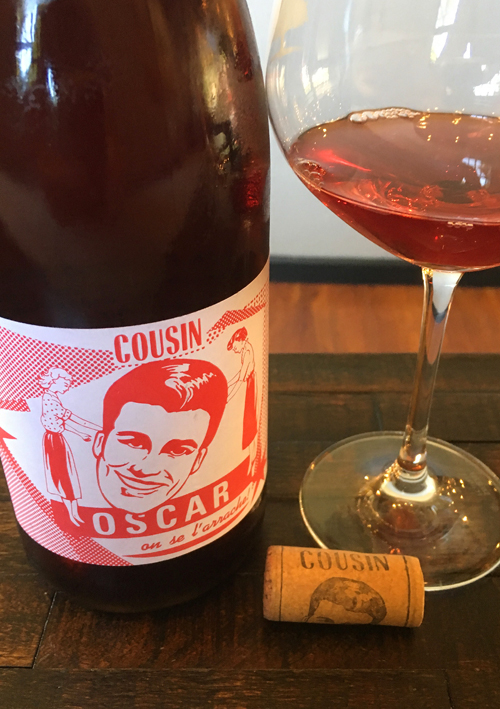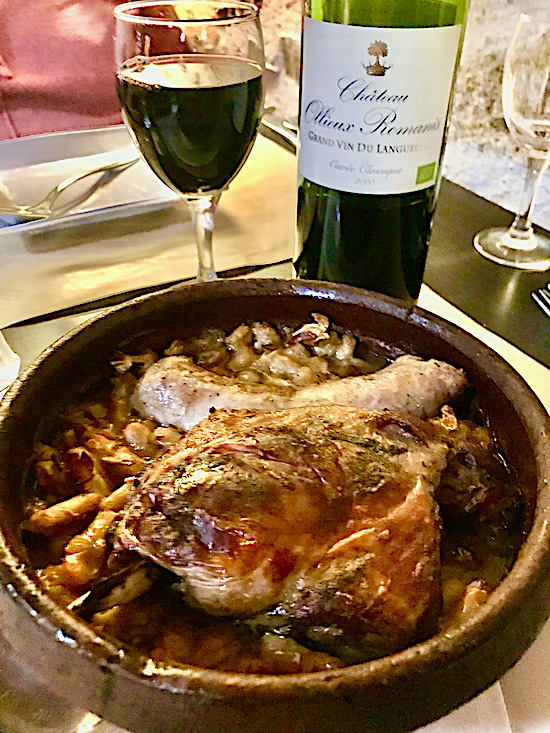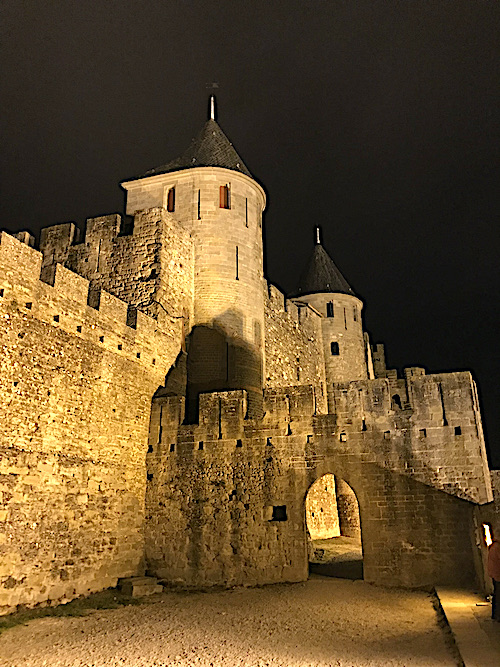Grapelive Cassoulet Wine Suggestions
The Languedoc has many ancient secrets from their rustic Cassoulet to some of France’s most authentic and easy to drink food wines, like the wines from Corbieres, Minervois, Fitou, Maury, Saint-Cinian, Pic Saint Loup, Faugères and Picpoul-de-Pinet. The grapes here are mostly Rhone varietals with the reds made from combinations of Grenache, Cinsault, Carignan, Mourvèdre and Syrah along with a few examples of single varietal wines, like Rimbert’s 100% Cinsault Uncle Oscar and some rarities made from Cabernet Sauvignon, like Mas Daumas de Gassac, as well as some sweet Muscat wines. My journalist friend Bradley Gray was recently in Carcassonne, one of the most beautiful ancient walled city in the region with a historic castle and home to one of France’s most coveted peasant dishes, Cassoulet and he brought back a delicious and authentic recipe. His trip and stories have brought my own memories of wines from the Languedoc-Roussillon, see below for Bradley’s Recipe and my wine recommendations.

There are many fantastic Languedoc wines from which to chose and here are some of my favorite reds to enjoy with these hearty and rustic traditional Cassoulet dishes. -Kerry Winslow, grapelive.com

Languedoc Wines to Explore

Domaine Rimbert, Cinsault “Cousin Oscar” Vin de France, Saint Chinian, Languedoc, France.
The all natural 100% Cinsault Cousin Oscar from Domaine Rimbert is a tangy fresh red wine that is bursting with vibrancy and classic Cinsault character, and while his Carignan based Saint-Chinian wines are his serious offerings, I love this playful Glou Glou style wine with it’s low alcohol and tangy freshness. This new release of Cousin Oscar is vibrant with a light ruby hue in the glass and with a strawberry led profile that includes tree picked plum, sour cherry, rosewater, cinnamon/pepper spiciness and intense licorice notes. This vat raised Cinsault loves being served with a slight chill and with lighter cuisine, it perks up nicely with food lighting it to a weight similar to Pinot Noir and gains earthy tones and hints of lavender. This wine has a Natty following and features on some Nature Wine Bar lists, it succeeds in being an honest and delightful lighter style red.
Jean-Marie Rimbert, the self proclaimed defender of the Languedoc’s native Carignan grape, is a benchmark grower for the region and also a maverick, being one of the leading lights in the Saint-Chinian AOC. His Cousin Oscar is named for a family member that had a serious reputation with the women in the region, such was his looks and charm he was known, I hear, to have women fighting over his attention, and the label alludes to this and his playful character. Rimbert’s Carignan based reds are, as mentioned above, the more serious stuff and remind me a little of Maxime Magnon’s intriguing Coberieres wines, as well as some fresher (style) Gigondas producers, with its added doses of Grenache and Syrah adding lovely complexity. This Cousin Oscar is wonderful fun and well made, it should satisfy the Natty and non Natty crowd in equal measure. -Floraison Selections ($17)
Chateau La Roque, Pic St Loup “Cuvee les Vieilles Vignes de Mourvedre” Languedoc, France.
Chateau La Roque is one of my favorite producers and I have long admired the quality and soul found in their wines, especially this 100% Mourvedre red from Pic Saint Loup. This richly textured and deeply colored wine is super lavish and ripely flavored with an explosion of black and red fruits on the palate along with chewy tannins, mineral and wild herbs. The extroverted special Mourvedre cuvee from Chateau La Roque is mouth filling and hedonistic from start to finish and has a real Bandol like feel and even hints at Chateauneuf-du-Pape, making for a most pleasing red that way over delivers for the price. The palate flowers deep with blackberry, cherry liqueur, blueberry and plum fruit, touches of pepper, cassis and a sweet and savory meaty element. The finish is amazingly long and fruit driven to the end, while touches of burnt earth, garrigue and dried flowers add complexity. -Kermit Lynch ($26)
Clos Marie, Metairies du Clos, Pic Saint Loup, Vieilles Vignes, Languedoc, France.
This rare and deeply flavored Grenache and Syrah blend from Clos Marie is a rival for many a Chateauneuf and or Gigondas with wonderful pure fruit, spice and mineral essences to put a smile on any Rhone lovers face. The Metairies comes from very old vines, all biodynamic, on clay and limestone soils that maximize that impact of the fruit, handcrafted and artisan made this is a spectacular wine of quality and style. The nose has earth, flowers and sweet herbs to start with fresh berries and exotic liqueur notes leading to a dense and dramatic palate of dark fruits, cracked pepper, violets and chalky stones with boysenberry, plum, fig and plum along with hints of cassis, saline, peppercorns, truffle and black licorice. While rich and intense this red has plenty of juicy acidity to keep things fresh and vivid, this is beautiful stuff, especially with classic Cassoulet. -Beaune Imports ($30)
Chateau de Lascaux “Carra” Pic Saint Loup, Coteaux du Languedoc Rouge, France.
Jean-Benoît Cavalier’s Chateau de Lascaux is a wonderful domaine in the heart of the Midi, tucked in the foothills of the Cevennes mountain range in the Languedoc, where remarkable wines are made, including this beautiful cuvee Carra made from 60% Syrah and 40% Grenache, grown on limestone soils within the Pic Saint Loup area. Lauscaux’s whites are terrific as well, these are all exotic and flavor filled wines of quality, character and distinction, with this year’s Carra being one of my favorites, it shows ripe fruit, mineral intensity and a savory tone along with textural charm and density, finishing with vivid clarity. The added details of garrigue, licorice and pepper add style and the core boysenberry, blueberry, pomegranate and raspberry fruits hit all the right notes, as well as background notes of warm earth, chalk and kirsch that highlight the terroir and complexity in this pleasure driven red. The Syrah really adds power and substance in this vintage, while the Grenache adds a heady hedonism that is seductive, this is a positively a drink now wine that oozes sex appeal. -Kermit Lynch ($24)
Maxime Magnon, Rozeta, Corbieres Rouge, Languedoc-Roussillon, France.
Magnon is an all natural producer is the wilds of the Languedoc in Vallee du Paradis and he crafts wines from field blend vineyards in Corbieres. These are beautiful, almost delicate wines, all organic and without the addition of sulfur, he learned his winemaking at the famed Morgon cellar of Jean Foillard and has been mentored also by Didier Barral in Faugeres. Maxime uses native yeasts and used Chassagne-Montrachet barrels to make his wines, the grapes are fermented whole cluster and all are co-fermented, the blend in this gorgeous Rozeta Corbieres is unique with varietals that include Carignan, Grenache and Syrah, but also has Grenache Gris, Macabou and Terret which are grayish and white grapes that add acidity, pigment and are in a way like Cote-Rotie is with the Syrah and Viognier. The soils part a part in the character in Magnon’s wines with limestone and schist adding complexity, mineral and spicy notes to these wonderfully textured and vibrant expressions of terroir. Wild strawberry and vine picked red berries which together with stemmy savory tones, spice and lavender make this a lovely wine all year long! -Kermit Lynch ($49)
Mas de Daumas Gassac, Haute Vallee du Gassac Rouge, Vin de Pays de L’Herault, Languedoc, France.
The Guibert family’s Mas de Daumas Gassac Grand Vin Rouge is a unique Bordeaux driven blend made from about 80% Cabernet Sauvignon along with about 20% of other grapes which could include Merlot, Cabernet Franc, Syrah, Tannat, Petit Verdot, Malbec, Pinot Noir, with later vintages having some Dolcetto and even some Nebbiolo. Founded in 1971 Mas de Daumas Gassac is set on iron rich red soils in a glacial formed valley in the Saint-Guilhem-le-Désert – Cité d’Aniane area of the L’Herault region of the Languedoc, it’s one of the most iconic estates of the south of France making this unique Red as well as also their equally unique and famous White that is mostly Petit Manseng, Viognier, Chardonnay and Chenin Blanc. The Guibert family now led by Samuel Guilbert, son of legendary Aimé Guibert who planted Cabernet Sauvignon from the Bordeaux’s Medoc. Each vintage is slightly different but always dark, rustic and powerful, needing robust cuisine to bring out its best, with Cassoulet being a wonderful companion to this Languedoc Grand Cru! -Beaune Imports ($65)
Traditional Cassoulet de Castelnaudary Recipe, by Bradley Gray
(Serves 4)

Ingredients:
1 pound great northern beans (Tarbais beans if you can find them)
1 quart duck stock (or chicken stock w/ 2 packets unflavored gelatin)
7 ounces salt pork
3 tablespoons Rendered Duck Fat
4 Toulouse Sausages
4 Duck Confit Legs
1 Onion
2 Carrots
2 Celery Stalks
2 Bay Leaves
10 Peppercorns
10 Whole Cloves
8 Garlic Cloves
4 Parsley Sprigs (including stems)
4 Thyme Sprigs
Day 1
Soak the beans overnight in cold water. Check periodically to make sure the beans are covered in water, as they do absorb.
Day 2
Drain water from soaked beans. Put beans in a Dutch oven or large pot, cover with cold water, bring to a boil, drain water, set beans aside.
If using store bought chicken stock instead of duck stock, place chicken stock in a bowl and add 2 packets of unflavored powdered gelatin.
Cut salt pork into 1/2 inch cubes.
Heat rendered duck fat over high heat in dutch oven. Add salt pork cubes and brown on all sides. Remove salt pork cubes with a slotted spoon and set aside.
Add sausages to fat and brown on all sides. Transfer to bowl with salt pork. If using chicken instead of duck confit, brown the chicken too. Transfer to bowl with sausage and salt pork.
Reduce heat and add the finely chopped onion and cook until translucent.
Wrap all of the bouquet garni items (2 carrots cut into thirds, 2 celery sticks cut into thirds, 2 bay leaves, 10 peppercorns, 8 garlic cloves, peeled but not chopped, 10 whole cloves, 4 large parsley sprigs including stems, 4 thyme sprigs) in a cheesecloth packet, as it will all be removed later. I find that a large clean tube sock is a nice substitute for cheesecloth. Tie it off when all ingredients are in. I told you this is a peasant dish!
Add bouquet garni, beans and stock to the Dutch oven. Bring to a boil, reduce heat and simmer uncovered for 45 minutes, flipping the bouquet garni several times to incorporate flavor.
Remove and discard bouquet garni and stir to blend flavors.
If you are using cassole or oven safe individual bowls: Assemble the Cassoulet in individual oven safe serving bowls if you plan to serve it that way. Each bowl should contain 1/4 of the lardons, placed in the bottom of the bowl, beans, 1 sausage and 1 confit, skin side up. The sausage and confit should be visible on the surface.
If you are serving from the Dutch oven: Add lardons, sausages and duck confit, skin side up, keeping the sausage and confit visible on the surface.
Place in 280 degree oven, uncovered until a crust forms on the surface (about two hours). Make sure the beans are staying covered, as you will need to add a little water or broth periodically, carefully to the side, so it flows into the casserole, not over the crust.
Note: At this point, if you would like to refrigerate, you may. It will hold for several days in the fridge. Before continuing, allow it to come back to room temperature. Part of the tradition of Cassoulet is to cook it, allow it to cool, and then cook it again.
Day 3
If refrigerated, bring back to temp in a 280 degree oven.
“Break” the crust every 30 minutes for the next 4 hours and allow underneath liquid to flow over the crust (jiggle the pot or cassole).
At the 4 hour mark, stop breaking the crust. Continue cooking for another hour.
Serve immediately, bubbling hot.
READ FULL ARTICLE by Bradley Gray, Guest Contributor at Grapelive.com
